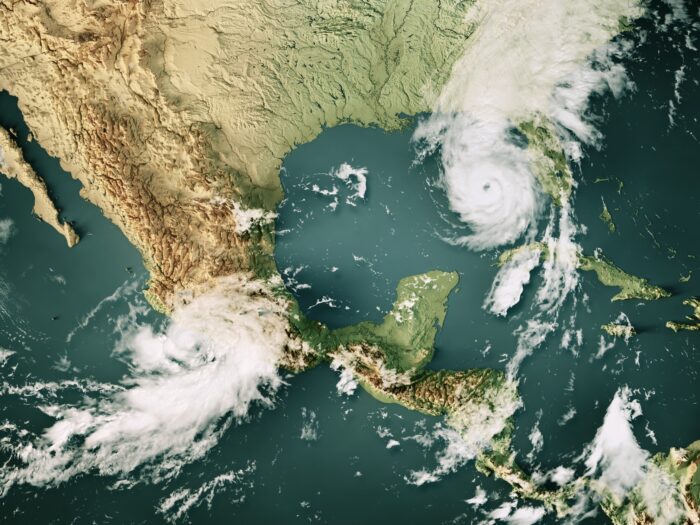P&C Insurers Well-Positioned for 2025 Hurricane Season Despite Above-Normal Forecast: Fitch

The North Atlantic Basin storm season for 2025 is forecast to range from average to slightly above average, following an active 2024 season that saw major hurricanes like Beryl, Helene, Milton and Rafael cause significant insured losses, according to analysis by Fitch Ratings.
Early forecasts from Colorado State University (CSU) researchers indicate the upcoming Atlantic hurricane season will feature above-normal activity, though likely below 2024 levels, according to the report.
The CSU assessment is based on La Niña conditions expected to transition to ENSO neutral conditions over several months. While sea surface temperatures remain warmer than normal, they aren’t as warm as last year. The CSU forecast specifically notes “an above average probability for major hurricanes making landfall along the continental U.S. coastline and in the Caribbean.”
“The 2025 Atlantic hurricane season is forecast to be slightly above average, but recent premium rate increases, combined with benefits from legislative changes to the Florida market, and growth in surplus mean the market is better able to withstand extreme loss events,” Gerry Glombicki, senior director in Fitch Ratings insurance group, stated in the report.
The property and casualty insurance industry appears well-positioned to weather potential 2025 storms. P&C insurer policyholders’ surplus grew by 6.5% in 2024, reaching $1.1 trillion, with Fitch forecasting continued modest growth through 2025. This capital strength provides a substantial buffer against catastrophe losses, which remain “a prime source of underwriting volatility for insurers with property exposure.”
The 2024 hurricane season proved costly, with Hurricane Helene generating $16 billion in insured losses and $56 billion in economic losses, while Hurricane Milton caused $25 billion in insured losses and $38 billion in economic losses. These figures highlight the significant protection gap that exists, particularly for flood peril.
Florida’s Evolving Insurance Landscape
Florida’s property insurance market continues its transformation following years of volatility, the rating agency noted. Citizens Property Insurance Corporation, the state’s insurer of last resort, has seen policies in force decline from a peak of approximately 1.4 million in September 2023 to 841,000 as of May 2025. Fitch anticipates “the policy count will continue to decline in the near term as additional carriers garner interest in policy take-outs.”
This depopulation reflects the emerging impact of Florida’s legislative reforms implemented since 2019, which aimed to stabilize rapidly growing loss costs and excessive litigation. Key reforms included “removal of one-way attorney fees, prohibition of the assignment of benefits and limitations on the ability of policyholders to file bad faith claims against insurers.” While the report notes “initial indications show benefits of the reform,” it also acknowledges that “broader return of capacity from highly rated insurance carriers has been limited.”
For catastrophe protection, Citizens is securing $4.49 billion in reinsurance for 2025, with the majority ($3.125 billion) in catastrophe bonds. This includes “the second largest ever catastrophe bond issued at $1.525 billion by Everglades Re II Ltd. (Series 2025-1), providing three-year indemnity protection against annual aggregate named storms,” the report stated.
Meanwhile, the Florida Hurricane Catastrophe Fund (FHCF) faces a potential funding gap. For the 2025 hurricane season, FHCF has estimated liquid resources of $9 billion against a maximum statutory liability of $17 billion, creating an $8 billion shortfall that would require post-event bonding to cover a full-limit loss.
Reinsurance Market Dynamics and Risk Management
Midyear reinsurance renewals revealed a market in relative balance. Reinsurance pricing at renewals “remained adequate, although property rate softening continued, particularly for loss-free business, which was down 10% or more.” Despite high catastrophe losses in early 2025, primarily from California wildfires, “reinsurance supply remains robust and sufficient to meet increased demand,” according to Fitch.
Reinsurance capacity for the Florida market is increasing from both traditional and insurance-linked securities (ILS) sources, including record catastrophe bond issuances. However, this protection is “primarily being provided for higher catastrophe layers, as reinsurers have a limited appetite for lower-layer frequency coverage where elevated property losses persist.”
Demand for reinsurance has increased following 2024’s active hurricane season, with Florida property writers seeking additional protection, especially at higher coverage levels. This demand is further driven by “reduced coverage provided by the FHCF, with the retention raised by $2.0 billion to $11.3 billion, the addition of several new Florida start-up insurers and increased take-outs from Citizens.”
The report also highlights how risk assessment has evolved since Hurricane Andrew in 1992, which caused approximately $27 billion in damages ($16 billion insured). Adjusted for inflation and Florida’s significant population growth, a similar event today could cause losses exceeding $100 billion, Fitch noted.
Modern probabilistic catastrophe models now provide more sophisticated risk analysis, with Verisk Analytics estimating the global insured annual aggregate loss for 2024 at $151 billion, with North America accounting for $97 billion—underscoring “the high level of property values exposed to catastrophe risk in North America,” the report concluded.
Obtain the full report here. &










